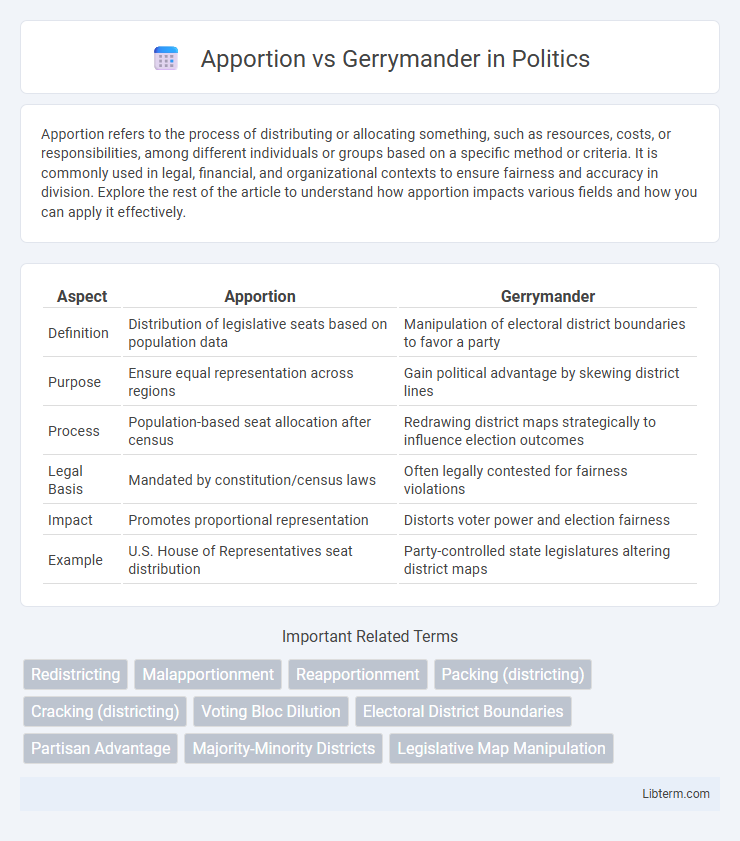Apportion refers to the process of distributing or allocating something, such as resources, costs, or responsibilities, among different individuals or groups based on a specific method or criteria. It is commonly used in legal, financial, and organizational contexts to ensure fairness and accuracy in division. Explore the rest of the article to understand how apportion impacts various fields and how you can apply it effectively.
Table of Comparison
| Aspect | Apportion | Gerrymander |
|---|---|---|
| Definition | Distribution of legislative seats based on population data | Manipulation of electoral district boundaries to favor a party |
| Purpose | Ensure equal representation across regions | Gain political advantage by skewing district lines |
| Process | Population-based seat allocation after census | Redrawing district maps strategically to influence election outcomes |
| Legal Basis | Mandated by constitution/census laws | Often legally contested for fairness violations |
| Impact | Promotes proportional representation | Distorts voter power and election fairness |
| Example | U.S. House of Representatives seat distribution | Party-controlled state legislatures altering district maps |
Understanding Apportionment: Definition and Purpose
Apportionment is the process of distributing legislative seats among geographic regions based on population data from the census, ensuring equal representation in government bodies like the U.S. House of Representatives. Its purpose is to maintain a balanced and fair allocation of political power by reflecting demographic changes across states or districts. Apportionment differs from gerrymandering, which manipulates district boundaries for partisan advantage rather than equitable representation.
What is Gerrymandering? Key Concepts Explained
Gerrymandering is the manipulation of electoral district boundaries to favor a specific political party or group, often resulting in districts with irregular shapes designed to dilute opposing votes. Key concepts include "cracking," which splits a voting bloc across multiple districts to weaken their influence, and "packing," which concentrates opposition voters into a single district to reduce their power elsewhere. This practice undermines representative democracy by skewing election outcomes and diminishing electoral competitiveness.
Apportionment vs Gerrymander: Core Differences
Apportionment determines the fair distribution of legislative seats based on population data from the census, ensuring equal representation across districts. Gerrymandering manipulates district boundaries to favor a specific political party or group, often diluting the voting power of opposition. While apportionment upholds democratic principles through objective allocation, gerrymandering undermines fairness by creating biased district maps.
Historical Context: Evolution of Apportionment and Gerrymandering
Apportionment originated from the Constitutional mandate in 1790 to allocate House seats based on census data, ensuring equitable representation among states. Gerrymandering emerged in the early 19th century, notably with Massachusetts Governor Elbridge Gerry's 1812 redistricting plan, designed to manipulate district boundaries for political advantage. Over time, apportionment has evolved with Supreme Court rulings like Baker v. Carr (1962), enforcing "one person, one vote," while gerrymandering techniques have become more sophisticated, incorporating computer algorithms to maximize partisan gains.
Legal Framework: Laws Governing Apportionment and Gerrymandering
Laws governing apportionment are primarily established by the U.S. Constitution and reinforced by landmark Supreme Court rulings such as Baker v. Carr and Reynolds v. Sims, which mandate districts to have roughly equal populations to ensure fair representation. Gerrymandering, the manipulation of district boundaries for political advantage, is subject to legal scrutiny under the Voting Rights Act of 1965, which prohibits district lines that dilute minority voting power. Courts apply standards like the "one person, one vote" principle and assess claims of racial or partisan gerrymandering, though the legality of partisan gerrymandering remains a complex and evolving issue in federal and state jurisprudence.
Impact on Representation: Fairness and Consequences
Apportioning ensures fair representation by distributing legislative seats based on accurate population data, promoting equal voting power across districts. Gerrymandering manipulates district boundaries to favor specific parties or groups, undermining electoral fairness and diluting the voting strength of certain populations. The consequences of gerrymandering include reduced political competition, distorted policy outcomes, and decreased public trust in democratic processes.
Techniques and Methods Used in Gerrymandering
Gerrymandering involves manipulating electoral district boundaries using techniques such as cracking, which dilutes opposition voters across many districts, and packing, which concentrates them into a few to reduce their influence elsewhere. These methods exploit geographic and demographic data to create districts that favor a specific party or group, often using sophisticated geographic information systems (GIS) tools for precise boundary drawing. Unlike apportionment, which allocates seats based on population counts without bias, gerrymandering intentionally distorts representation for political gain.
Notable Examples: Apportionment and Gerrymandering in Practice
Notable examples of apportionment include the decennial U.S. Census, which determines congressional seat distribution based on population shifts, such as the 2020 Census leading to Texas gaining two seats while California lost one. Gerrymandering is famously illustrated by North Carolina's 2016 congressional maps, which courts ruled as racially and politically biased to favor one party. These cases highlight the impact of apportionment on fair representation and how gerrymandering manipulates district boundaries to influence electoral outcomes.
Reform Efforts: Combating Gerrymandering and Promoting Fair Apportionment
Reform efforts to combat gerrymandering and promote fair apportionment include independent redistricting commissions, algorithm-based mapping, and legal challenges to partisan maps. States like California and Arizona have successfully implemented citizen-led commissions to create more balanced districts, reducing partisan bias and enhancing electoral competitiveness. Legislative initiatives aim to standardize fair apportionment practices nationwide, ensuring equal representation and protecting democratic integrity.
Future Outlook: Ensuring Equitable Political Representation
Apportionment establishes the legal framework for distributing legislative seats based on population data, aiming to reflect demographic shifts accurately. Gerrymandering manipulates district boundaries to favor specific political interests, undermining fair representation and skewing electoral outcomes. Future efforts must prioritize transparent redistricting processes and independent commissions to safeguard equitable political representation and uphold democratic integrity.
Apportion Infographic

 libterm.com
libterm.com